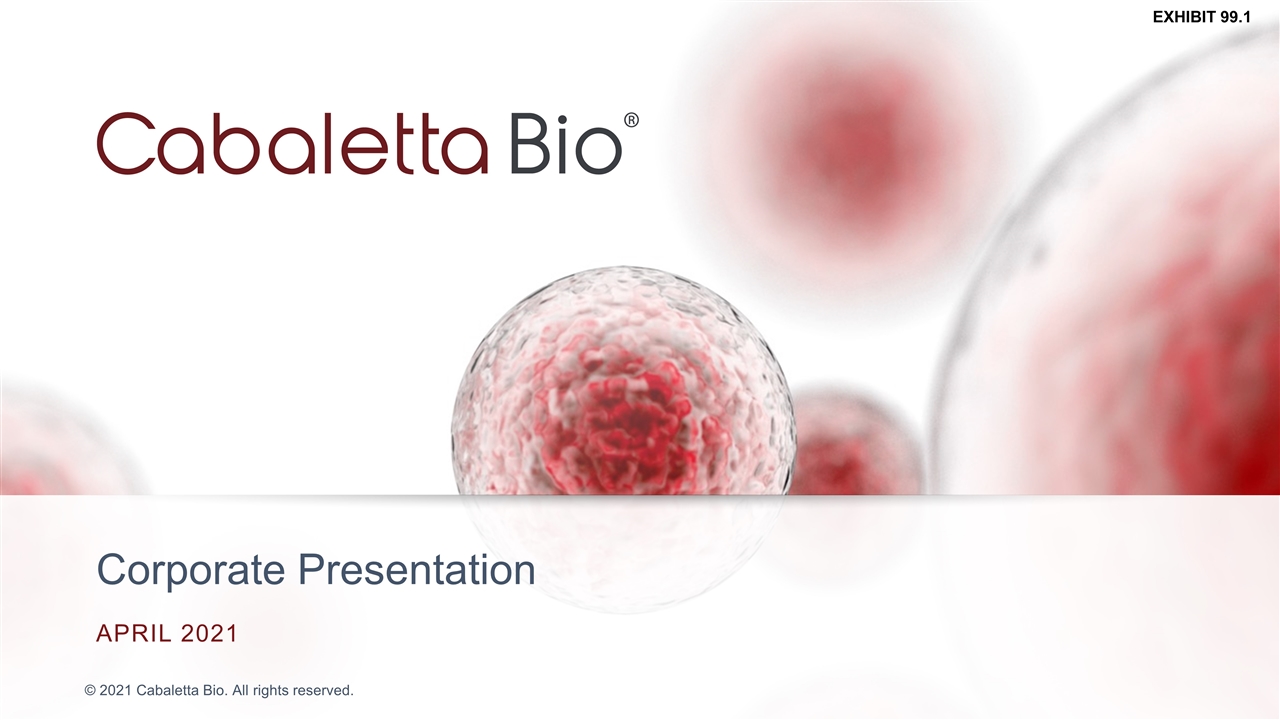

Corporate Presentation April 2021 EXHIBIT 99.1
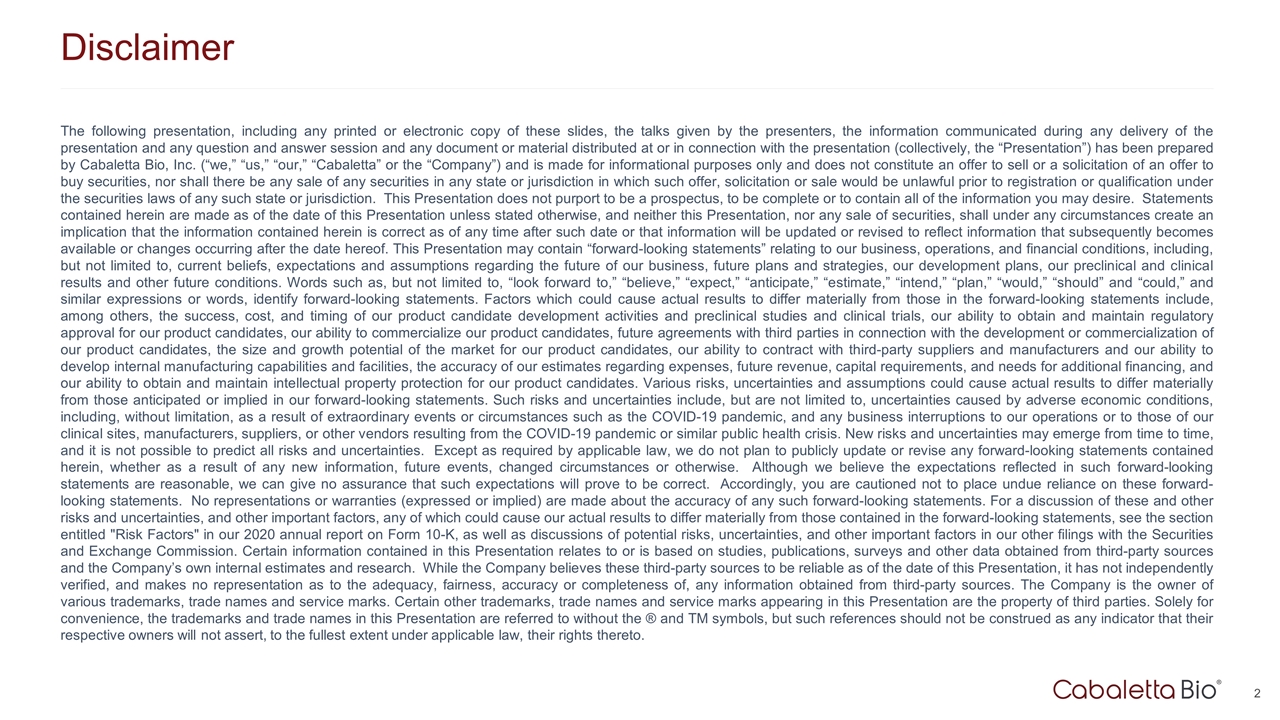
Disclaimer The following presentation, including any printed or electronic copy of these slides, the talks given by the presenters, the information communicated during any delivery of the presentation and any question and answer session and any document or material distributed at or in connection with the presentation (collectively, the “Presentation”) has been prepared by Cabaletta Bio, Inc. (“we,” “us,” “our,” “Cabaletta” or the “Company”) and is made for informational purposes only and does not constitute an offer to sell or a solicitation of an offer to buy securities, nor shall there be any sale of any securities in any state or jurisdiction in which such offer, solicitation or sale would be unlawful prior to registration or qualification under the securities laws of any such state or jurisdiction. This Presentation does not purport to be a prospectus, to be complete or to contain all of the information you may desire. Statements contained herein are made as of the date of this Presentation unless stated otherwise, and neither this Presentation, nor any sale of securities, shall under any circumstances create an implication that the information contained herein is correct as of any time after such date or that information will be updated or revised to reflect information that subsequently becomes available or changes occurring after the date hereof. This Presentation may contain “forward-looking statements” relating to our business, operations, and financial conditions, including, but not limited to, current beliefs, expectations and assumptions regarding the future of our business, future plans and strategies, our development plans, our preclinical and clinical results and other future conditions. Words such as, but not limited to, “look forward to,” “believe,” “expect,” “anticipate,” “estimate,” “intend,” “plan,” “would,” “should” and “could,” and similar expressions or words, identify forward-looking statements. Factors which could cause actual results to differ materially from those in the forward-looking statements include, among others, the success, cost, and timing of our product candidate development activities and preclinical studies and clinical trials, our ability to obtain and maintain regulatory approval for our product candidates, our ability to commercialize our product candidates, future agreements with third parties in connection with the development or commercialization of our product candidates, the size and growth potential of the market for our product candidates, our ability to contract with third-party suppliers and manufacturers and our ability to develop internal manufacturing capabilities and facilities, the accuracy of our estimates regarding expenses, future revenue, capital requirements, and needs for additional financing, and our ability to obtain and maintain intellectual property protection for our product candidates. Various risks, uncertainties and assumptions could cause actual results to differ materially from those anticipated or implied in our forward-looking statements. Such risks and uncertainties include, but are not limited to, uncertainties caused by adverse economic conditions, including, without limitation, as a result of extraordinary events or circumstances such as the COVID-19 pandemic, and any business interruptions to our operations or to those of our clinical sites, manufacturers, suppliers, or other vendors resulting from the COVID-19 pandemic or similar public health crisis. New risks and uncertainties may emerge from time to time, and it is not possible to predict all risks and uncertainties. Except as required by applicable law, we do not plan to publicly update or revise any forward-looking statements contained herein, whether as a result of any new information, future events, changed circumstances or otherwise. Although we believe the expectations reflected in such forward-looking statements are reasonable, we can give no assurance that such expectations will prove to be correct. Accordingly, you are cautioned not to place undue reliance on these forward-looking statements. No representations or warranties (expressed or implied) are made about the accuracy of any such forward-looking statements. For a discussion of these and other risks and uncertainties, and other important factors, any of which could cause our actual results to differ materially from those contained in the forward-looking statements, see the section entitled "Risk Factors" in our 2020 annual report on Form 10-K, as well as discussions of potential risks, uncertainties, and other important factors in our other filings with the Securities and Exchange Commission. Certain information contained in this Presentation relates to or is based on studies, publications, surveys and other data obtained from third-party sources and the Company’s own internal estimates and research. While the Company believes these third-party sources to be reliable as of the date of this Presentation, it has not independently verified, and makes no representation as to the adequacy, fairness, accuracy or completeness of, any information obtained from third-party sources. The Company is the owner of various trademarks, trade names and service marks. Certain other trademarks, trade names and service marks appearing in this Presentation are the property of third parties. Solely for convenience, the trademarks and trade names in this Presentation are referred to without the ® and TM symbols, but such references should not be construed as any indicator that their respective owners will not assert, to the fullest extent under applicable law, their rights thereto.

Develop and launch the first curative targeted cellular therapies for patients with autoimmune diseases
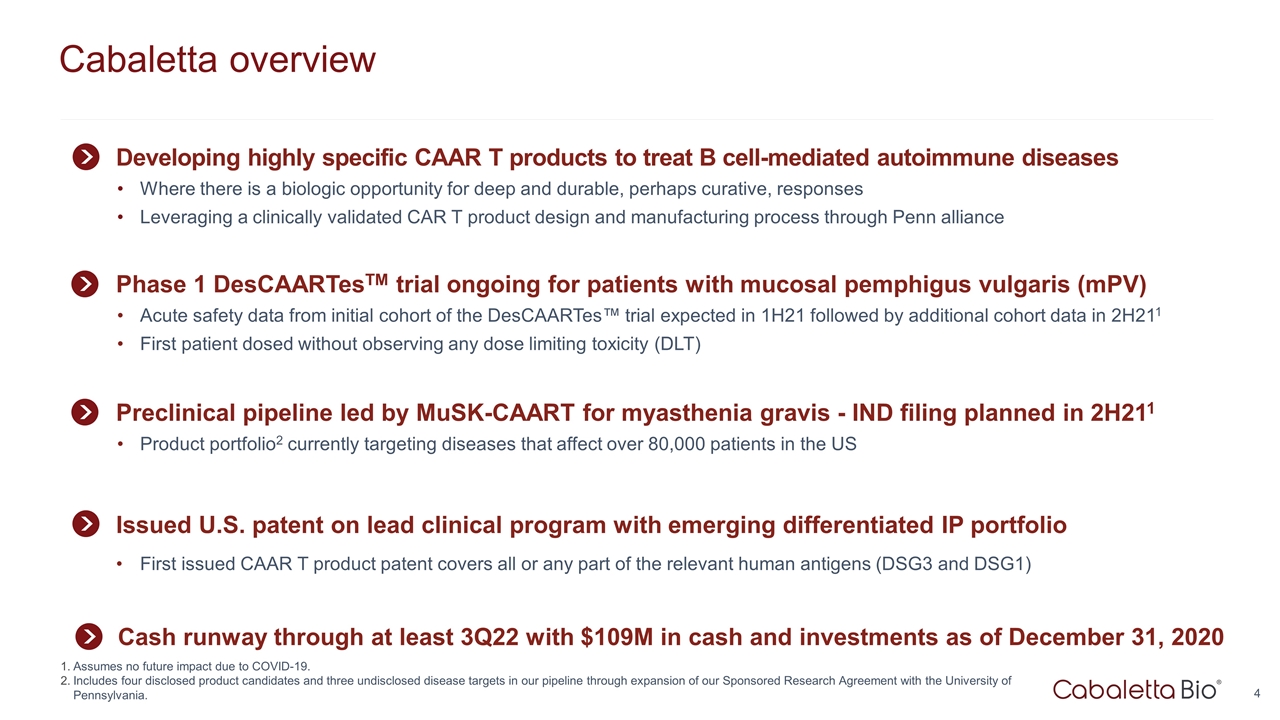
Cabaletta overview Developing highly specific CAAR T products to treat B cell-mediated autoimmune diseases Where there is a biologic opportunity for deep and durable, perhaps curative, responses Leveraging a clinically validated CAR T product design and manufacturing process through Penn alliance Preclinical pipeline led by MuSK-CAART for myasthenia gravis - IND filing planned in 2H211 Product portfolio2 currently targeting diseases that affect over 80,000 patients in the US Issued U.S. patent on lead clinical program with emerging differentiated IP portfolio First issued CAAR T product patent covers all or any part of the relevant human antigens (DSG3 and DSG1) Phase 1 DesCAARTesTM trial ongoing for patients with mucosal pemphigus vulgaris (mPV) Acute safety data from initial cohort of the DesCAARTes™ trial expected in 1H21 followed by additional cohort data in 2H211 First patient dosed without observing any dose limiting toxicity (DLT) Cash runway through at least 3Q22 with $109M in cash and investments as of December 31, 2020 Assumes no future impact due to COVID-19. Includes four disclosed product candidates and three undisclosed disease targets in our pipeline through expansion of our Sponsored Research Agreement with the University of Pennsylvania.
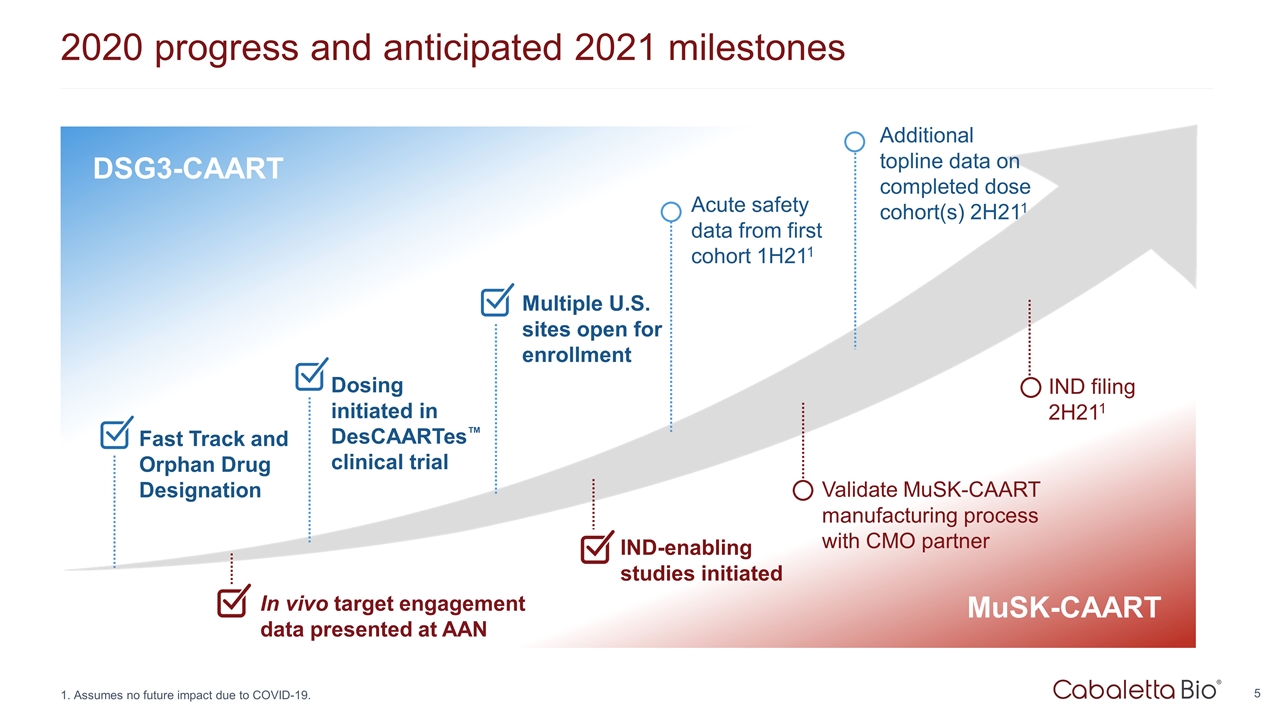
2020 progress and anticipated 2021 milestones Validate MuSK-CAART manufacturing process with CMO partner DSG3-CAART Multiple U.S. sites open for enrollment Dosing initiated in DesCAARTes™ clinical trial Acute safety data from first cohort 1H211 In vivo target engagement data presented at AAN MuSK-CAART Fast Track and Orphan Drug Designation IND-enabling studies initiated IND filing 2H211 1. Assumes no future impact due to COVID-19. Additional topline data on completed dose cohort(s) 2H211
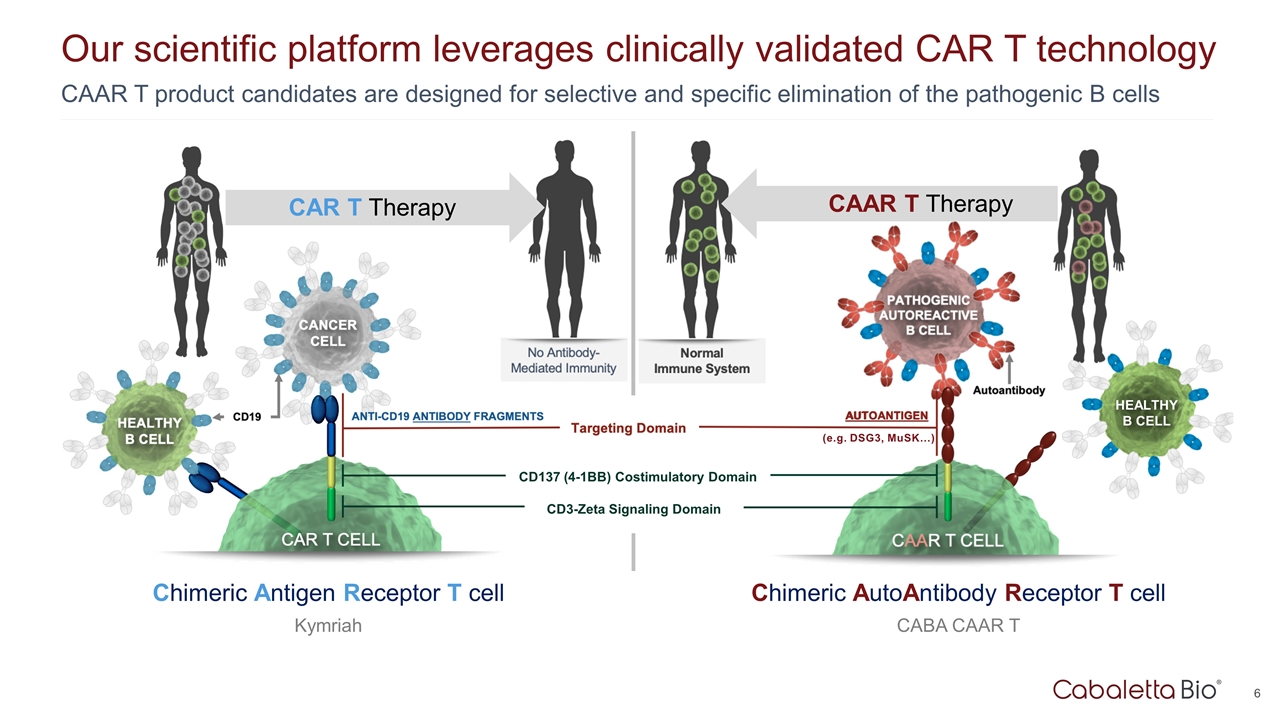
Our scientific platform leverages clinically validated CAR T technology CAR T Therapy Chimeric Antigen Receptor T cell Kymriah CAAR T product candidates are designed for selective and specific elimination of the pathogenic B cells CAAR T Therapy Chimeric AutoAntibody Receptor T cell CABA CAAR T AUTOANTIGEN (e.g. DSG3, MuSK…) CD137 (4-1BB) Costimulatory Domain CD3-Zeta Signaling Domain HEALTHY B CELL
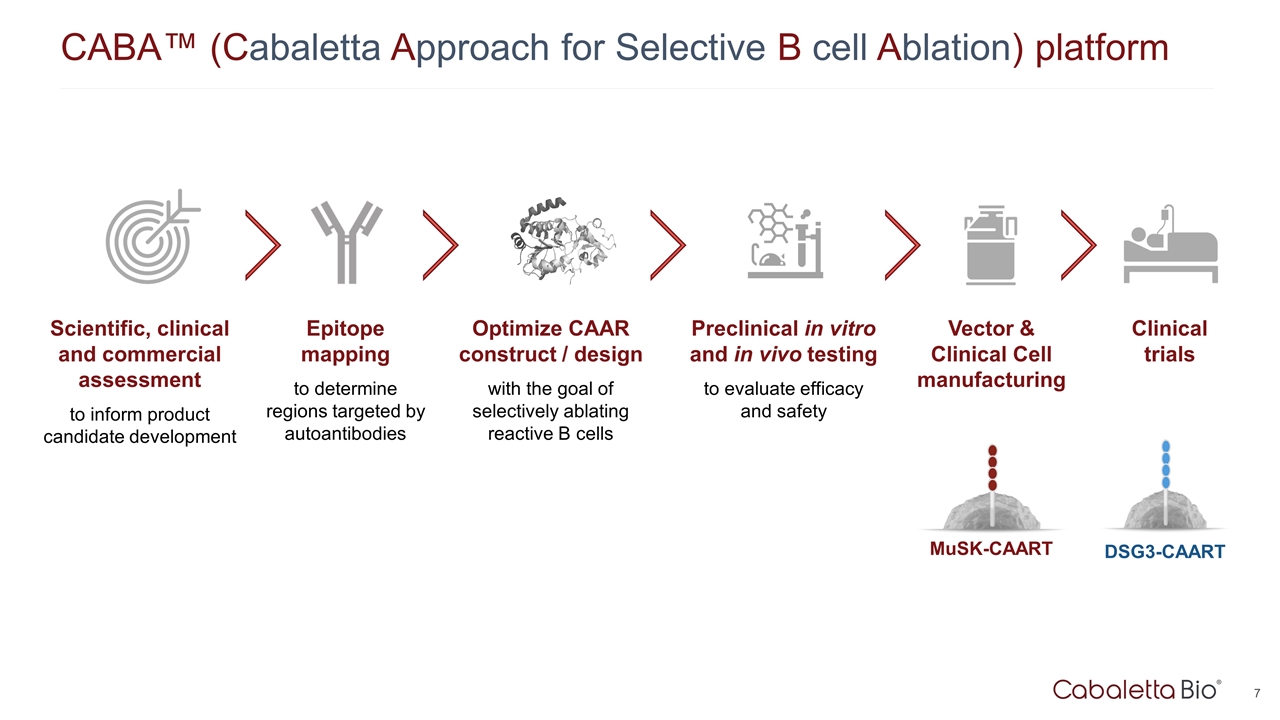
CABA™ (Cabaletta Approach for Selective B cell Ablation) platform Epitope mapping to determine regions targeted by autoantibodies Optimize CAAR construct / design with the goal of selectively ablating reactive B cells Preclinical in vitro and in vivo testing to evaluate efficacy and safety Scientific, clinical and commercial assessment to inform product candidate development Vector & Clinical Cell manufacturing Clinical trials DSG3-CAART MuSK-CAART
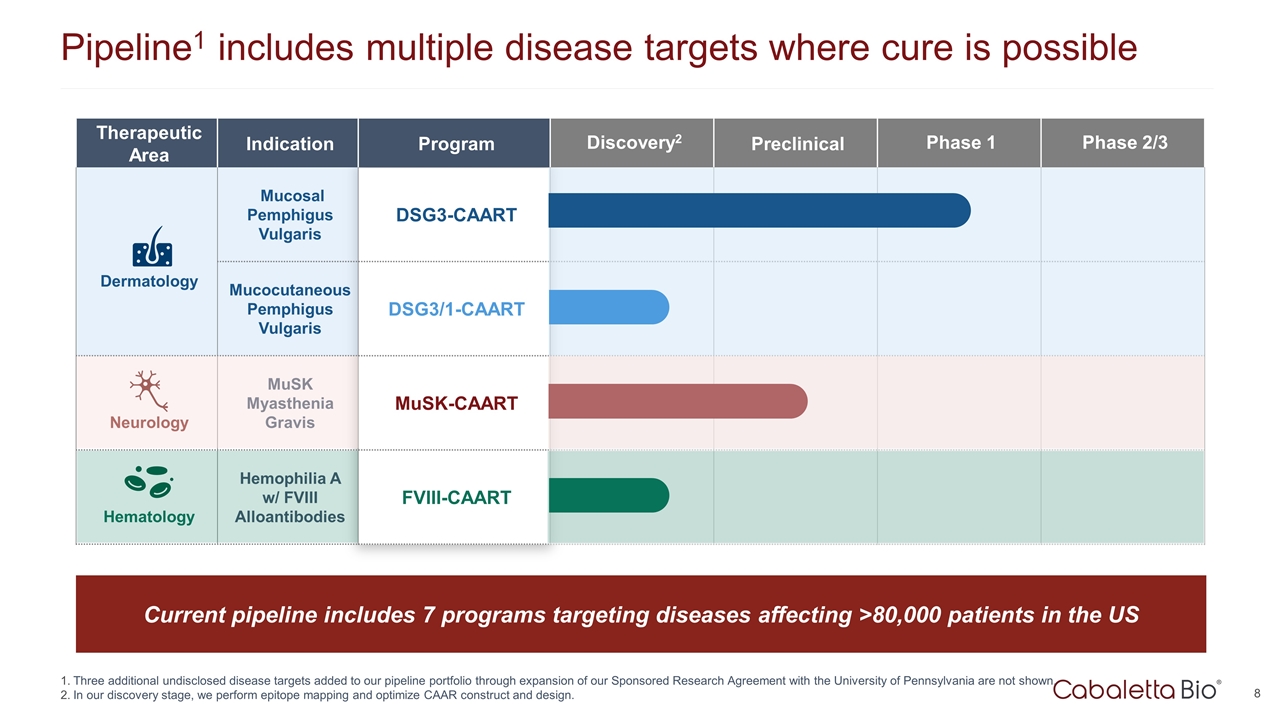
Therapeutic Area Indication Program Discovery2 Preclinical Phase 1 Phase 2/3 Dermatology Mucosal Pemphigus Vulgaris DSG3-CAART Mucocutaneous Pemphigus Vulgaris DSG3/1-CAART Neurology MuSK Myasthenia Gravis MuSK-CAART Hematology Hemophilia A w/ FVIII Alloantibodies FVIII-CAART Pipeline1 includes multiple disease targets where cure is possible Three additional undisclosed disease targets added to our pipeline portfolio through expansion of our Sponsored Research Agreement with the University of Pennsylvania are not shown. In our discovery stage, we perform epitope mapping and optimize CAAR construct and design. Current pipeline includes 7 programs targeting diseases affecting >80,000 patients in the US
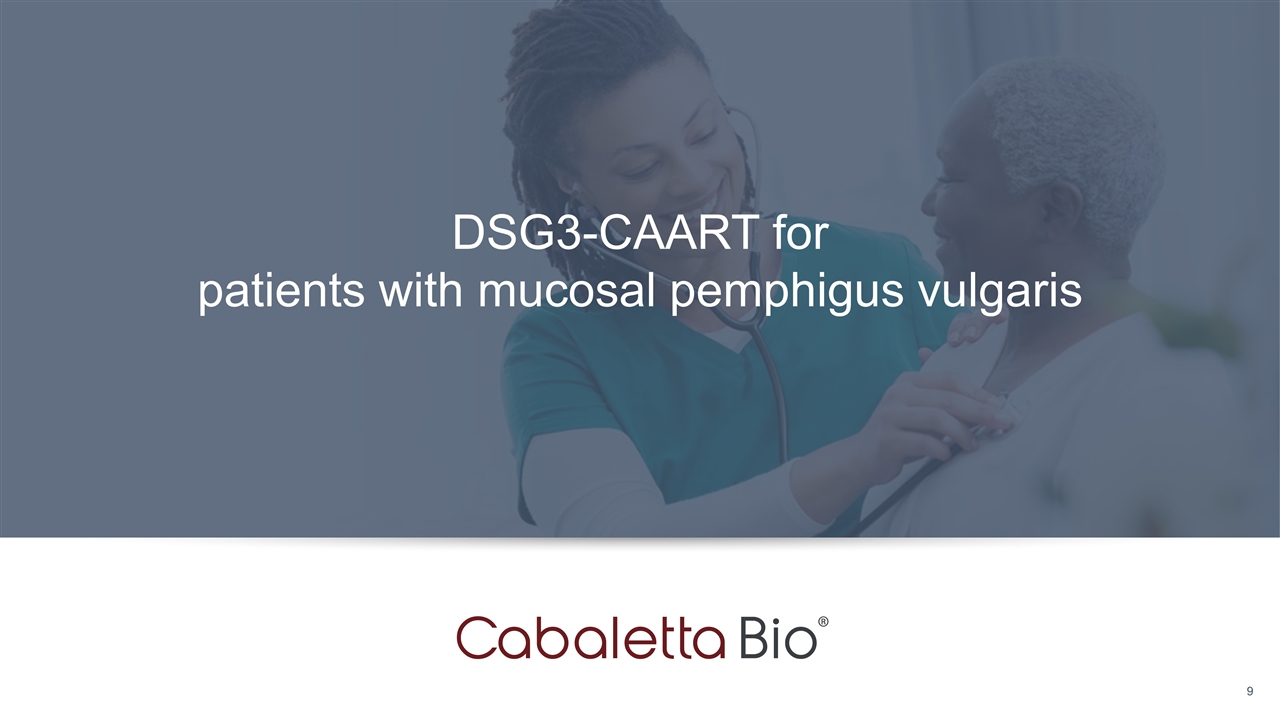
DSG3-CAART for patients with mucosal pemphigus vulgaris
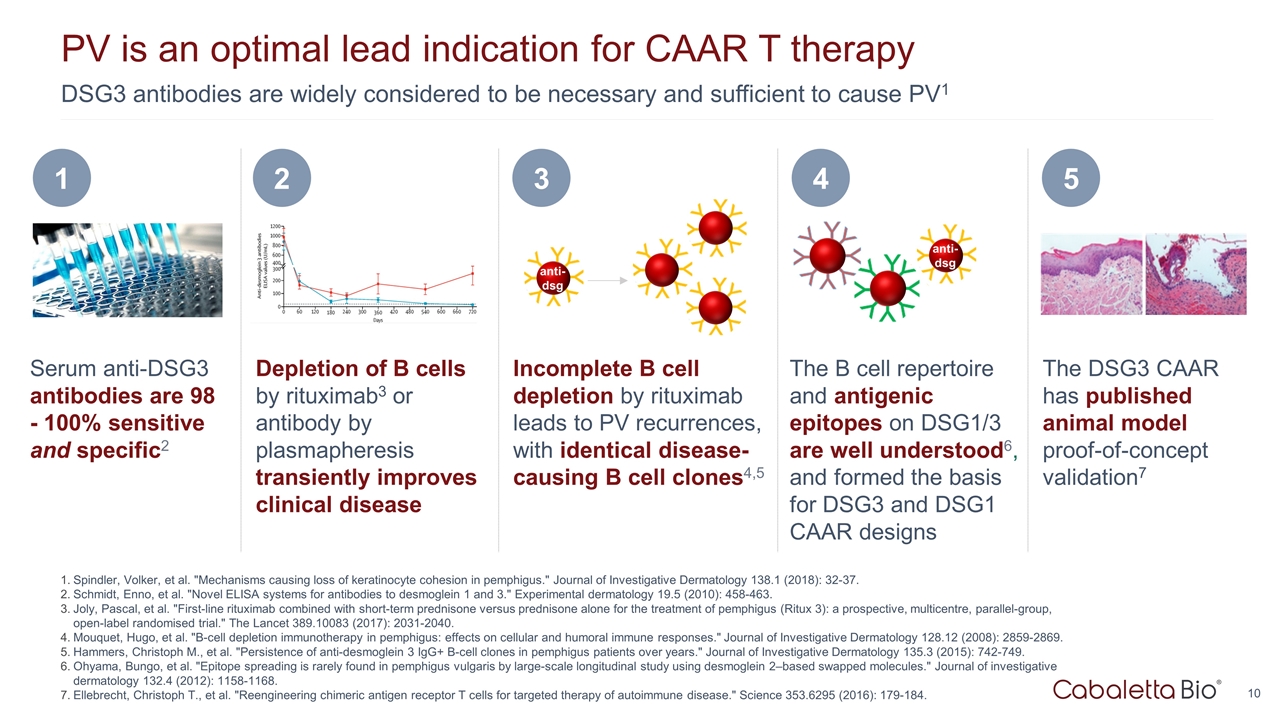
DSG3 antibodies are widely considered to be necessary and sufficient to cause PV1 PV is an optimal lead indication for CAAR T therapy Spindler, Volker, et al. "Mechanisms causing loss of keratinocyte cohesion in pemphigus." Journal of Investigative Dermatology 138.1 (2018): 32-37. Schmidt, Enno, et al. "Novel ELISA systems for antibodies to desmoglein 1 and 3." Experimental dermatology 19.5 (2010): 458-463. Joly, Pascal, et al. "First-line rituximab combined with short-term prednisone versus prednisone alone for the treatment of pemphigus (Ritux 3): a prospective, multicentre, parallel-group, open-label randomised trial." The Lancet 389.10083 (2017): 2031-2040. Mouquet, Hugo, et al. "B-cell depletion immunotherapy in pemphigus: effects on cellular and humoral immune responses." Journal of Investigative Dermatology 128.12 (2008): 2859-2869. Hammers, Christoph M., et al. "Persistence of anti-desmoglein 3 IgG+ B-cell clones in pemphigus patients over years." Journal of Investigative Dermatology 135.3 (2015): 742-749. Ohyama, Bungo, et al. "Epitope spreading is rarely found in pemphigus vulgaris by large-scale longitudinal study using desmoglein 2–based swapped molecules." Journal of investigative dermatology 132.4 (2012): 1158-1168. Ellebrecht, Christoph T., et al. "Reengineering chimeric antigen receptor T cells for targeted therapy of autoimmune disease." Science 353.6295 (2016): 179-184. Serum anti-DSG3 antibodies are 98 - 100% sensitive and specific2 1 The DSG3 CAAR has published animal model proof-of-concept validation7 5 Depletion of B cells by rituximab3 or antibody by plasmapheresis transiently improves clinical disease 2 The B cell repertoire and antigenic epitopes on DSG1/3 are well understood6, and formed the basis for DSG3 and DSG1 CAAR designs 4 Incomplete B cell depletion by rituximab leads to PV recurrences, with identical disease-causing B cell clones4,5 3 anti- dsg anti- dsg
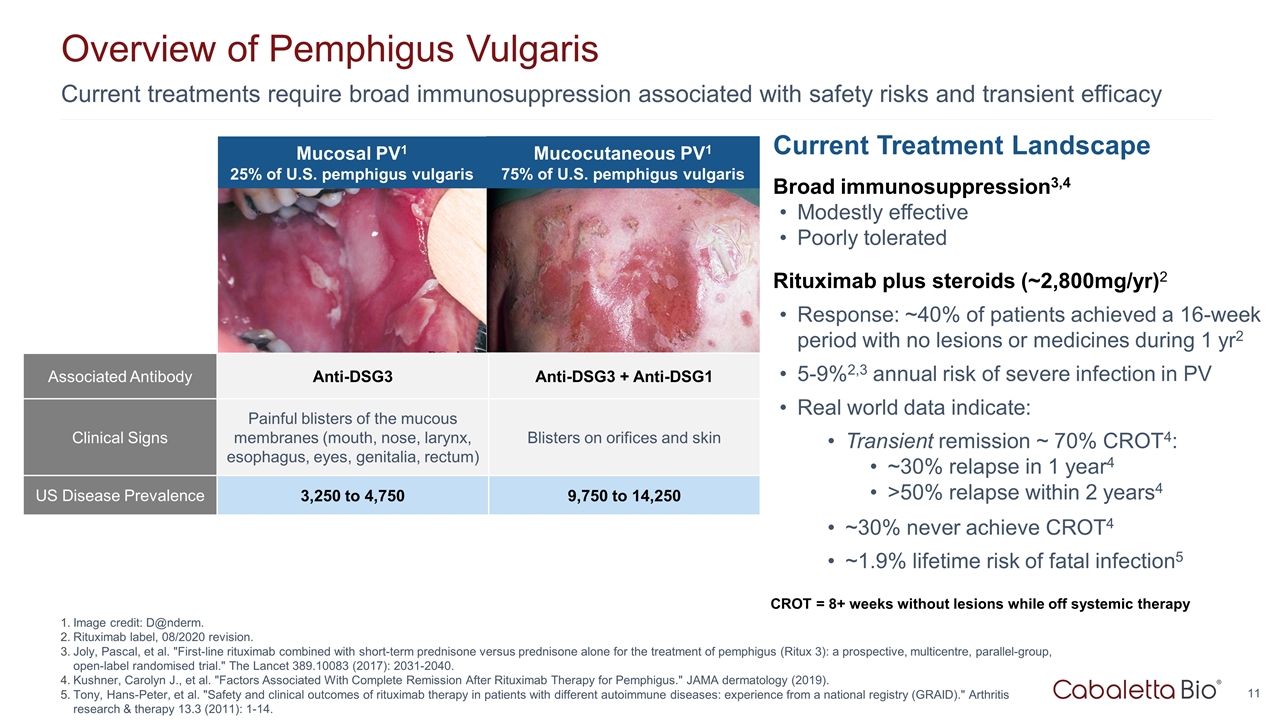
Current treatments require broad immunosuppression associated with safety risks and transient efficacy Overview of Pemphigus Vulgaris Image credit: D@nderm. Rituximab label, 08/2020 revision. Joly, Pascal, et al. "First-line rituximab combined with short-term prednisone versus prednisone alone for the treatment of pemphigus (Ritux 3): a prospective, multicentre, parallel-group, open-label randomised trial." The Lancet 389.10083 (2017): 2031-2040. Kushner, Carolyn J., et al. "Factors Associated With Complete Remission After Rituximab Therapy for Pemphigus." JAMA dermatology (2019). Tony, Hans-Peter, et al. "Safety and clinical outcomes of rituximab therapy in patients with different autoimmune diseases: experience from a national registry (GRAID)." Arthritis research & therapy 13.3 (2011): 1-14. Current Treatment Landscape Broad immunosuppression3,4 Modestly effective Poorly tolerated Rituximab plus steroids (~2,800mg/yr)2 Response: ~40% of patients achieved a 16-week period with no lesions or medicines during 1 yr2 5-9%2,3 annual risk of severe infection in PV Real world data indicate: Transient remission ~ 70% CROT4: ~30% relapse in 1 year4 >50% relapse within 2 years4 ~30% never achieve CROT4 ~1.9% lifetime risk of fatal infection5 CROT = 8+ weeks without lesions while off systemic therapy http://www.danderm-pdv.is.kkh.dk/atlas/3-157.html http://www.dermis.net/bilder/CD008/550px/img0042.jpg Mucosal PV1 25% of U.S. pemphigus vulgaris Mucocutaneous PV1 75% of U.S. pemphigus vulgaris Associated Antibody Anti-DSG3 Anti-DSG3 + Anti-DSG1 Clinical Signs Painful blisters of the mucous membranes (mouth, nose, larynx, esophagus, eyes, genitalia, rectum) Blisters on orifices and skin US Disease Prevalence 3,250 to 4,750 9,750 to 14,250
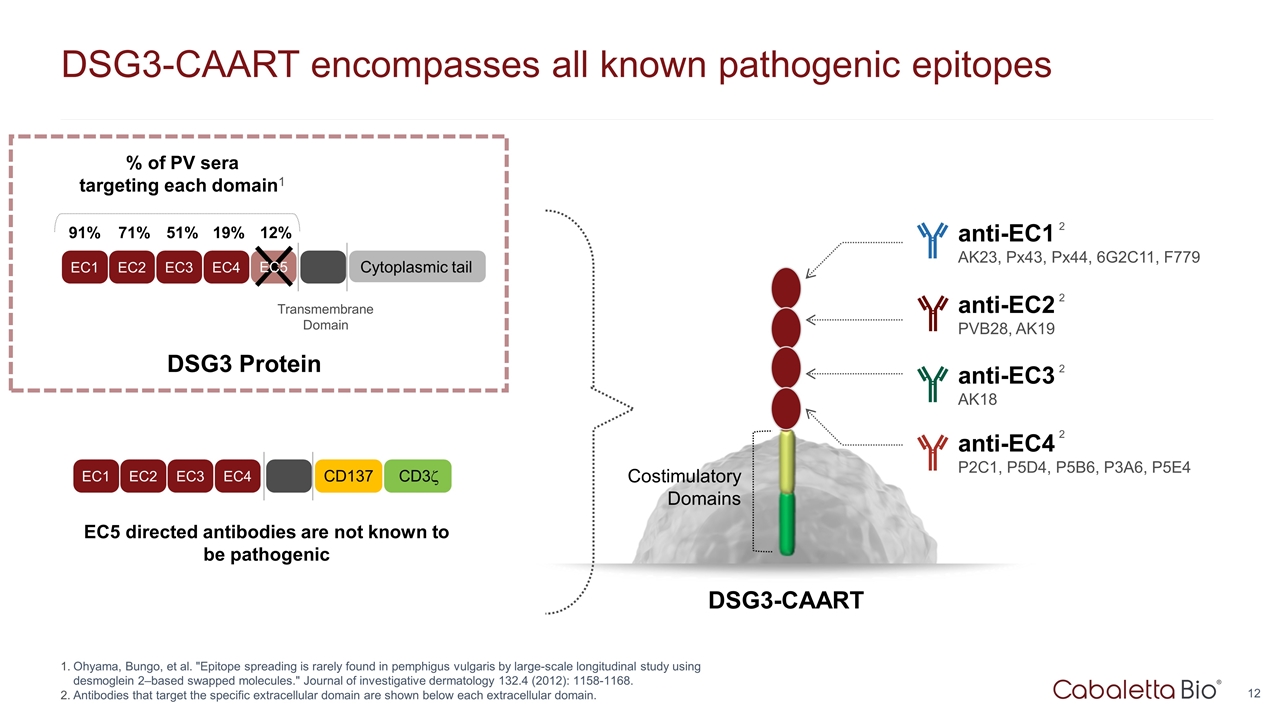
DSG3-CAART encompasses all known pathogenic epitopes Ohyama, Bungo, et al. "Epitope spreading is rarely found in pemphigus vulgaris by large-scale longitudinal study using desmoglein 2–based swapped molecules." Journal of investigative dermatology 132.4 (2012): 1158-1168. Antibodies that target the specific extracellular domain are shown below each extracellular domain. EC5 directed antibodies are not known to be pathogenic DSG3-CAART Costimulatory Domains anti-EC4 P2C1, P5D4, P5B6, P3A6, P5E4 2 anti-EC3 AK18 2 anti-EC2 PVB28, AK19 2 anti-EC1 AK23, Px43, Px44, 6G2C11, F779 2 EC1 EC2 EC3 EC4 Transmembrane Domain Cytoplasmic tail % of PV sera targeting each domain1 91% 71% 51% 19% 12% EC5 EC1 EC2 EC3 EC4 CD137 CD3z DSG3 Protein
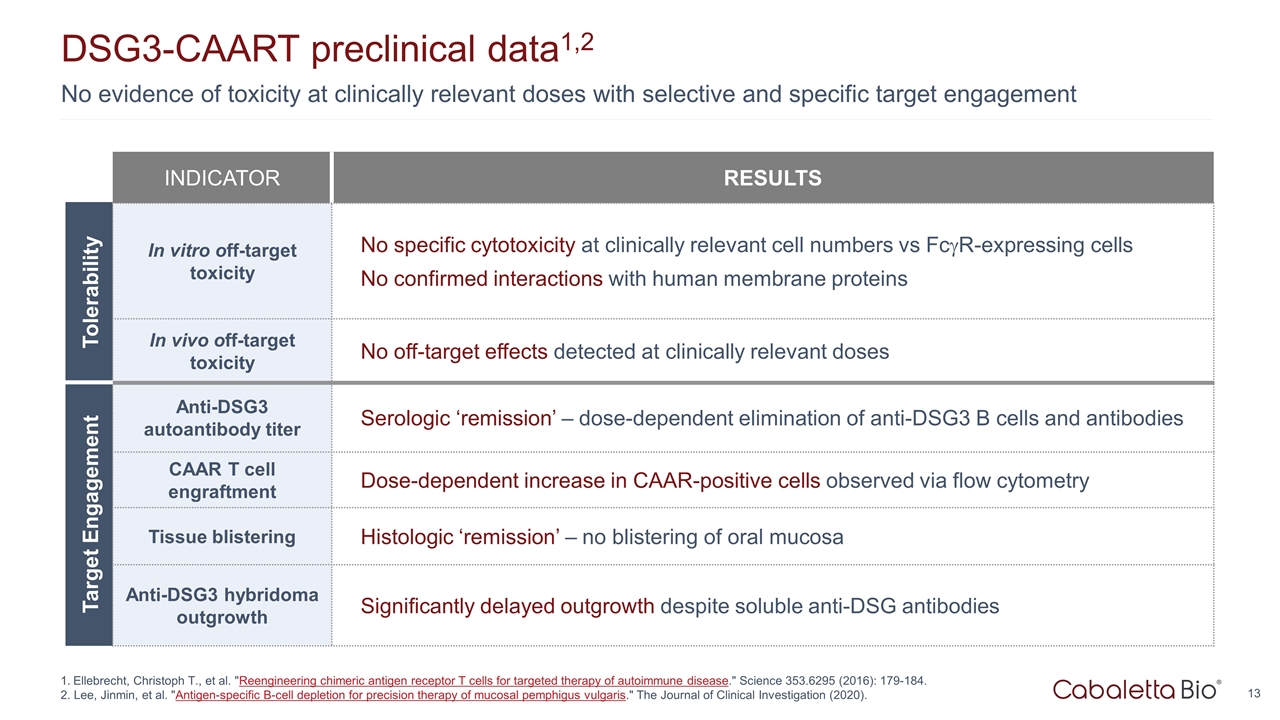
Tolerability Target Engagement No evidence of toxicity at clinically relevant doses with selective and specific target engagement DSG3-CAART preclinical data1,2 INDICATOR RESULTS In vitro off-target toxicity No specific cytotoxicity at clinically relevant cell numbers vs FcgR-expressing cells No confirmed interactions with human membrane proteins In vivo off-target toxicity No off-target effects detected at clinically relevant doses Anti-DSG3 autoantibody titer Serologic ‘remission’ – dose-dependent elimination of anti-DSG3 B cells and antibodies CAAR T cell engraftment Dose-dependent increase in CAAR-positive cells observed via flow cytometry Tissue blistering Histologic ‘remission’ – no blistering of oral mucosa Anti-DSG3 hybridoma outgrowth Significantly delayed outgrowth despite soluble anti-DSG antibodies Ellebrecht, Christoph T., et al. "Reengineering chimeric antigen receptor T cells for targeted therapy of autoimmune disease." Science 353.6295 (2016): 179-184. 2. Lee, Jinmin, et al. "Antigen-specific B-cell depletion for precision therapy of mucosal pemphigus vulgaris." The Journal of Clinical Investigation (2020).
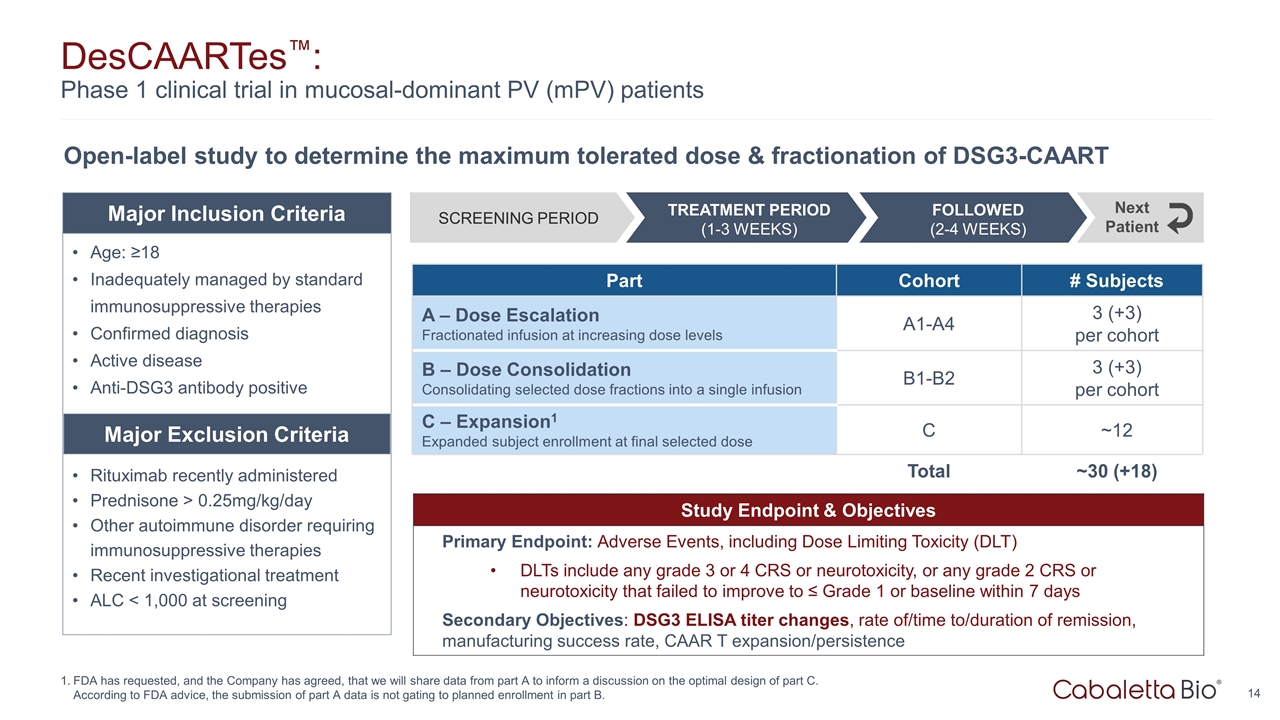
Study Endpoint & Objectives Primary Endpoint: Adverse Events, including Dose Limiting Toxicity (DLT) DLTs include any grade 3 or 4 CRS or neurotoxicity, or any grade 2 CRS or neurotoxicity that failed to improve to ≤ Grade 1 or baseline within 7 days Secondary Objectives: DSG3 ELISA titer changes, rate of/time to/duration of remission, manufacturing success rate, CAAR T expansion/persistence DesCAARTes™: Phase 1 clinical trial in mucosal-dominant PV (mPV) patients FDA has requested, and the Company has agreed, that we will share data from part A to inform a discussion on the optimal design of part C. According to FDA advice, the submission of part A data is not gating to planned enrollment in part B. Open-label study to determine the maximum tolerated dose & fractionation of DSG3-CAART Part Cohort # Subjects A – Dose Escalation Fractionated infusion at increasing dose levels A1-A4 3 (+3) per cohort B – Dose Consolidation Consolidating selected dose fractions into a single infusion B1-B2 3 (+3) per cohort C – Expansion1 Expanded subject enrollment at final selected dose C ~12 Total ~30 (+18) Age: ≥18 Inadequately managed by standard immunosuppressive therapies Confirmed diagnosis Active disease Anti-DSG3 antibody positive Rituximab recently administered Prednisone > 0.25mg/kg/day Other autoimmune disorder requiring immunosuppressive therapies Recent investigational treatment ALC < 1,000 at screening Major Inclusion Criteria Major Exclusion Criteria SCREENING PERIOD FOLLOWED (2-4 WEEKS) TREATMENT PERIOD (1-3 WEEKS) Next Patient
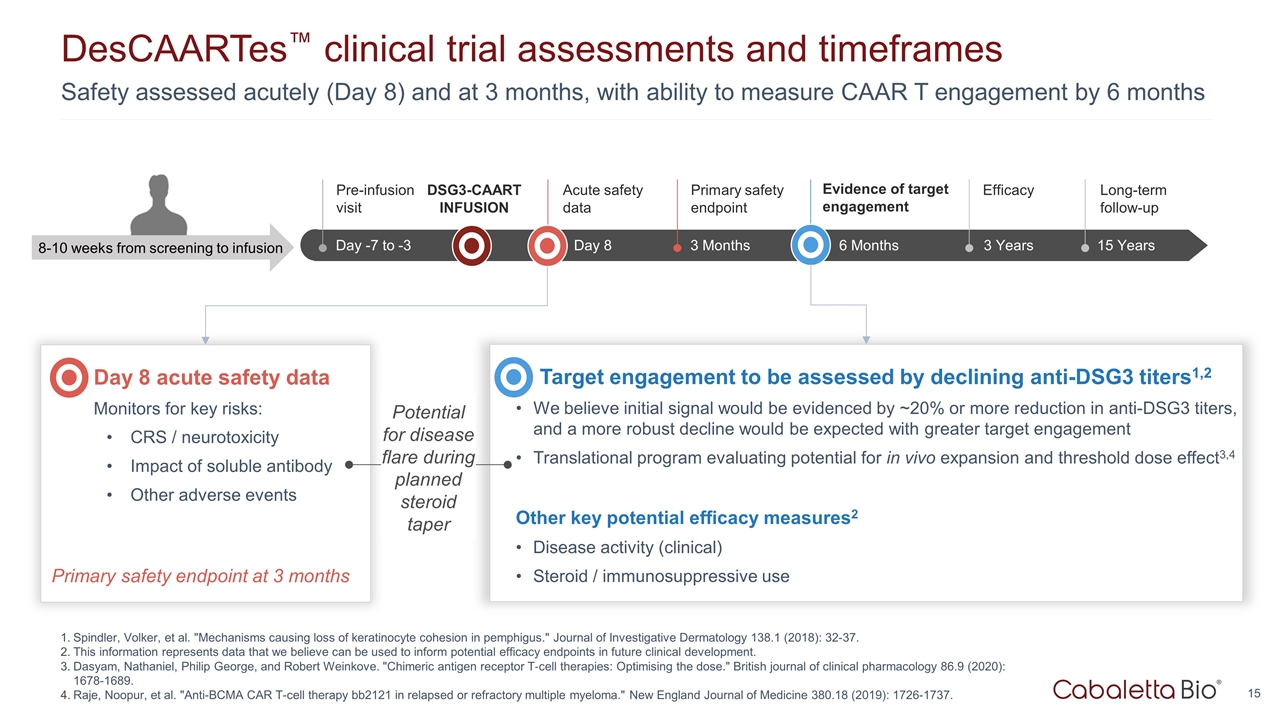
Safety assessed acutely (Day 8) and at 3 months, with ability to measure CAAR T engagement by 6 months DesCAARTes™ clinical trial assessments and timeframes Spindler, Volker, et al. "Mechanisms causing loss of keratinocyte cohesion in pemphigus." Journal of Investigative Dermatology 138.1 (2018): 32-37. This information represents data that we believe can be used to inform potential efficacy endpoints in future clinical development. Dasyam, Nathaniel, Philip George, and Robert Weinkove. "Chimeric antigen receptor T‐cell therapies: Optimising the dose." British journal of clinical pharmacology 86.9 (2020): 1678-1689. Raje, Noopur, et al. "Anti-BCMA CAR T-cell therapy bb2121 in relapsed or refractory multiple myeloma." New England Journal of Medicine 380.18 (2019): 1726-1737. Up to Wk -18 Wk -18 to -1 Day -7 to -3 Pre-infusion visit DSG3-CAART INFUSION Day 8 Acute safety data 3 Months Primary safety endpoint 6 Months Evidence of target engagement 3 Years Efficacy 15 Years Long-term follow-up 8-10 weeks from screening to infusion Day 8 acute safety data Monitors for key risks: CRS / neurotoxicity Impact of soluble antibody Other adverse events Target engagement to be assessed by declining anti-DSG3 titers1,2 We believe initial signal would be evidenced by ~20% or more reduction in anti-DSG3 titers, and a more robust decline would be expected with greater target engagement Translational program evaluating potential for in vivo expansion and threshold dose effect3,4 Other key potential efficacy measures2 Disease activity (clinical) Steroid / immunosuppressive use Primary safety endpoint at 3 months Potential for disease flare during planned steroid taper
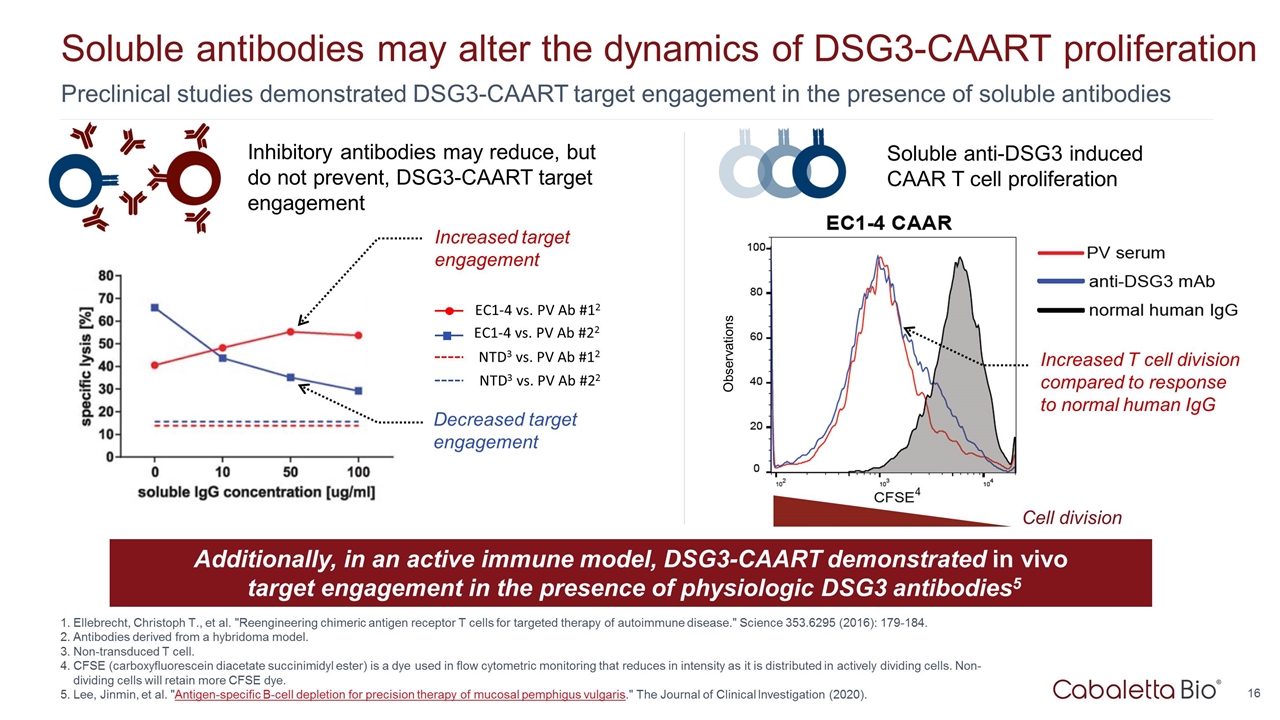
Preclinical studies demonstrated DSG3-CAART target engagement in the presence of soluble antibodies Soluble antibodies may alter the dynamics of DSG3-CAART proliferation Ellebrecht, Christoph T., et al. "Reengineering chimeric antigen receptor T cells for targeted therapy of autoimmune disease." Science 353.6295 (2016): 179-184. Antibodies derived from a hybridoma model. Non-transduced T cell. CFSE (carboxyfluorescein diacetate succinimidyl ester) is a dye used in flow cytometric monitoring that reduces in intensity as it is distributed in actively dividing cells. Non-dividing cells will retain more CFSE dye. Lee, Jinmin, et al. "Antigen-specific B-cell depletion for precision therapy of mucosal pemphigus vulgaris." The Journal of Clinical Investigation (2020). Soluble anti-DSG3 induced CAAR T cell proliferation Inhibitory antibodies may reduce, but do not prevent, DSG3-CAART target engagement Increased target engagement Decreased target engagement EC1-4 vs. PV Ab #12 EC1-4 vs. PV Ab #22 NTD3 vs. PV Ab #12 NTD3 vs. PV Ab #22 Cell division Increased T cell division compared to response to normal human IgG 4 Observations Additionally, in an active immune model, DSG3-CAART demonstrated in vivo target engagement in the presence of physiologic DSG3 antibodies5
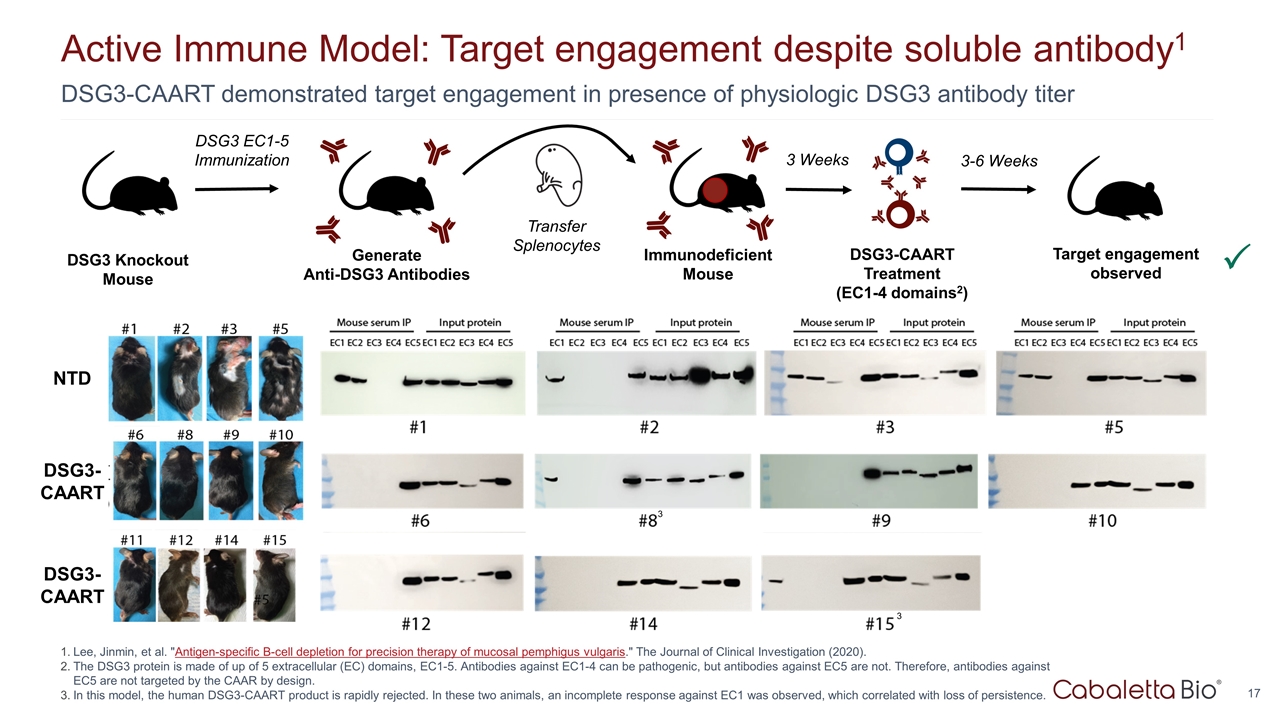
DSG3-CAART demonstrated target engagement in presence of physiologic DSG3 antibody titer Active Immune Model: Target engagement despite soluble antibody1 Lee, Jinmin, et al. "Antigen-specific B-cell depletion for precision therapy of mucosal pemphigus vulgaris." The Journal of Clinical Investigation (2020). The DSG3 protein is made of up of 5 extracellular (EC) domains, EC1-5. Antibodies against EC1-4 can be pathogenic, but antibodies against EC5 are not. Therefore, antibodies against EC5 are not targeted by the CAAR by design. In this model, the human DSG3-CAART product is rapidly rejected. In these two animals, an incomplete response against EC1 was observed, which correlated with loss of persistence. DSG3 Knockout Mouse DSG3 EC1-5 Immunization Generate Anti-DSG3 Antibodies Transfer Splenocytes Immunodeficient Mouse NTD DSG3- CAART DSG3- CAART 3 Weeks Target engagement observed 3-6 Weeks P DSG3-CAART Treatment (EC1-4 domains2) 3 3
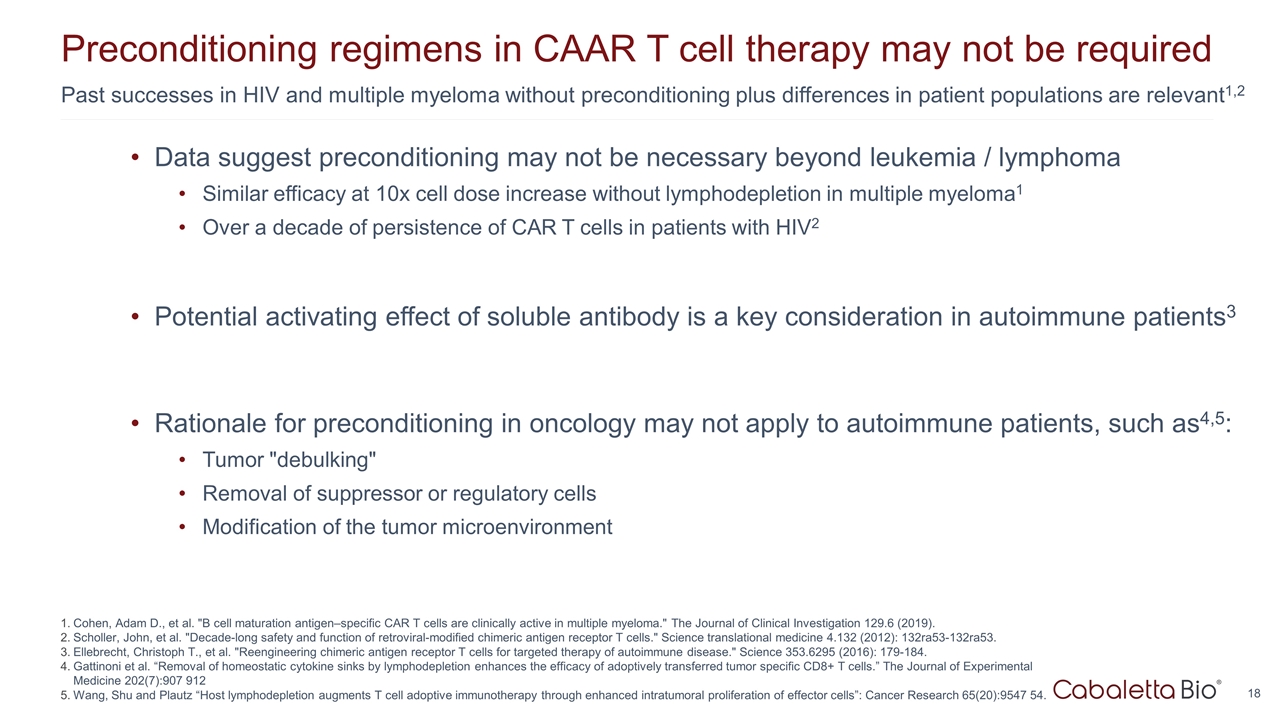
Data suggest preconditioning may not be necessary beyond leukemia / lymphoma Similar efficacy at 10x cell dose increase without lymphodepletion in multiple myeloma1 Over a decade of persistence of CAR T cells in patients with HIV2 Potential activating effect of soluble antibody is a key consideration in autoimmune patients3 Rationale for preconditioning in oncology may not apply to autoimmune patients, such as4,5: Tumor "debulking" Removal of suppressor or regulatory cells Modification of the tumor microenvironment Past successes in HIV and multiple myeloma without preconditioning plus differences in patient populations are relevant1,2 Preconditioning regimens in CAAR T cell therapy may not be required Cohen, Adam D., et al. "B cell maturation antigen–specific CAR T cells are clinically active in multiple myeloma." The Journal of Clinical Investigation 129.6 (2019). Scholler, John, et al. "Decade-long safety and function of retroviral-modified chimeric antigen receptor T cells." Science translational medicine 4.132 (2012): 132ra53-132ra53. Ellebrecht, Christoph T., et al. "Reengineering chimeric antigen receptor T cells for targeted therapy of autoimmune disease." Science 353.6295 (2016): 179-184. Gattinoni et al. “Removal of homeostatic cytokine sinks by lymphodepletion enhances the efficacy of adoptively transferred tumor specific CD8+ T cells.” The Journal of Experimental Medicine 202(7):907 912 Wang, Shu and Plautz “Host lymphodepletion augments T cell adoptive immunotherapy through enhanced intratumoral proliferation of effector cells”: Cancer Research 65(20):9547 54.
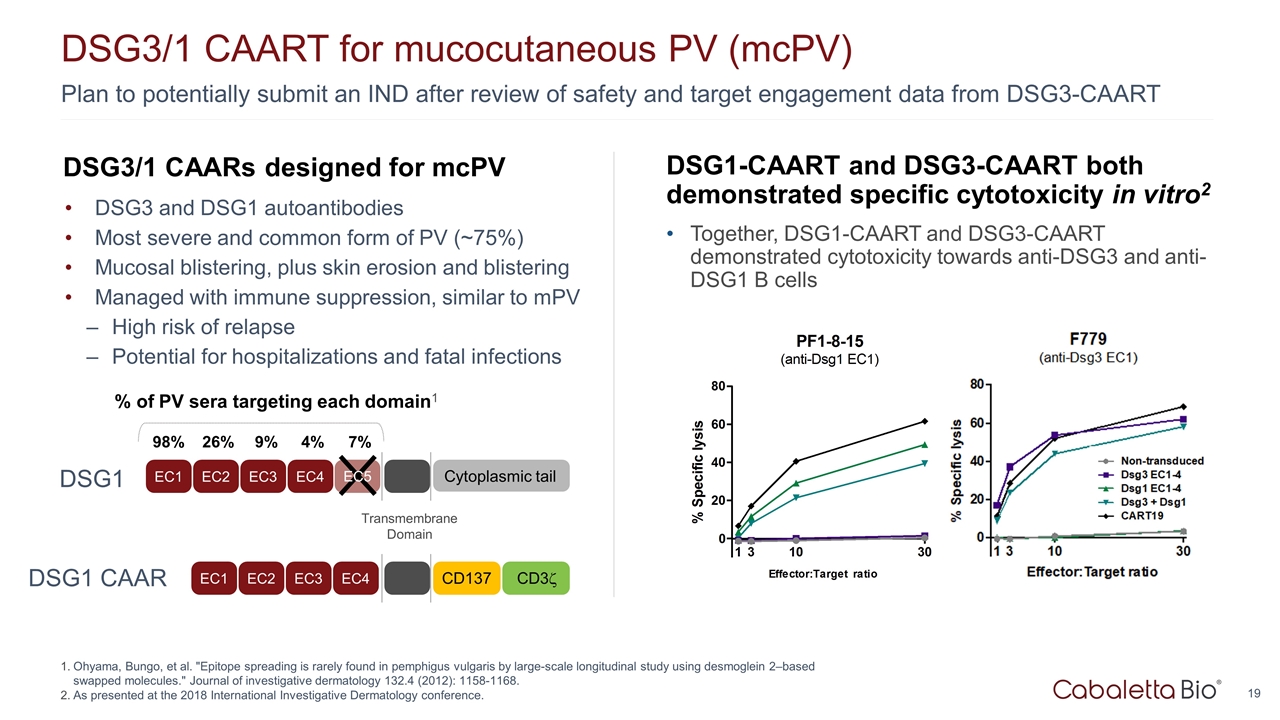
DSG3/1 CAARs designed for mcPV DSG3 and DSG1 autoantibodies Most severe and common form of PV (~75%) Mucosal blistering, plus skin erosion and blistering Managed with immune suppression, similar to mPV High risk of relapse Potential for hospitalizations and fatal infections Plan to potentially submit an IND after review of safety and target engagement data from DSG3-CAART DSG3/1 CAART for mucocutaneous PV (mcPV) Ohyama, Bungo, et al. "Epitope spreading is rarely found in pemphigus vulgaris by large-scale longitudinal study using desmoglein 2–based swapped molecules." Journal of investigative dermatology 132.4 (2012): 1158-1168. As presented at the 2018 International Investigative Dermatology conference. DSG1-CAART and DSG3-CAART both demonstrated specific cytotoxicity in vitro2 Together, DSG1-CAART and DSG3-CAART demonstrated cytotoxicity towards anti-DSG3 and anti-DSG1 B cells EC1 EC2 EC3 EC4 Transmembrane Domain Cytoplasmic tail % of PV sera targeting each domain1 98% 26% 9% 4% 7% EC5 EC1 EC2 EC3 EC4 CD137 CD3z DSG1 DSG1 CAAR
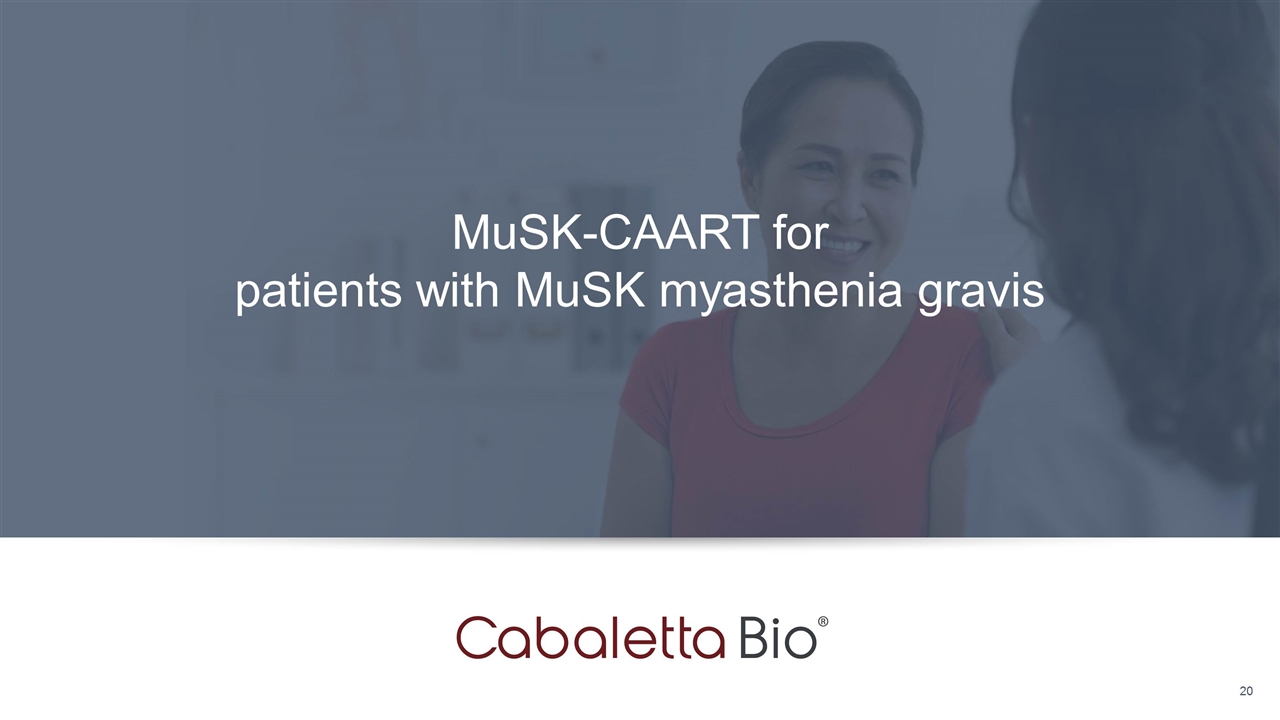
MuSK-CAART for patients with MuSK myasthenia gravis
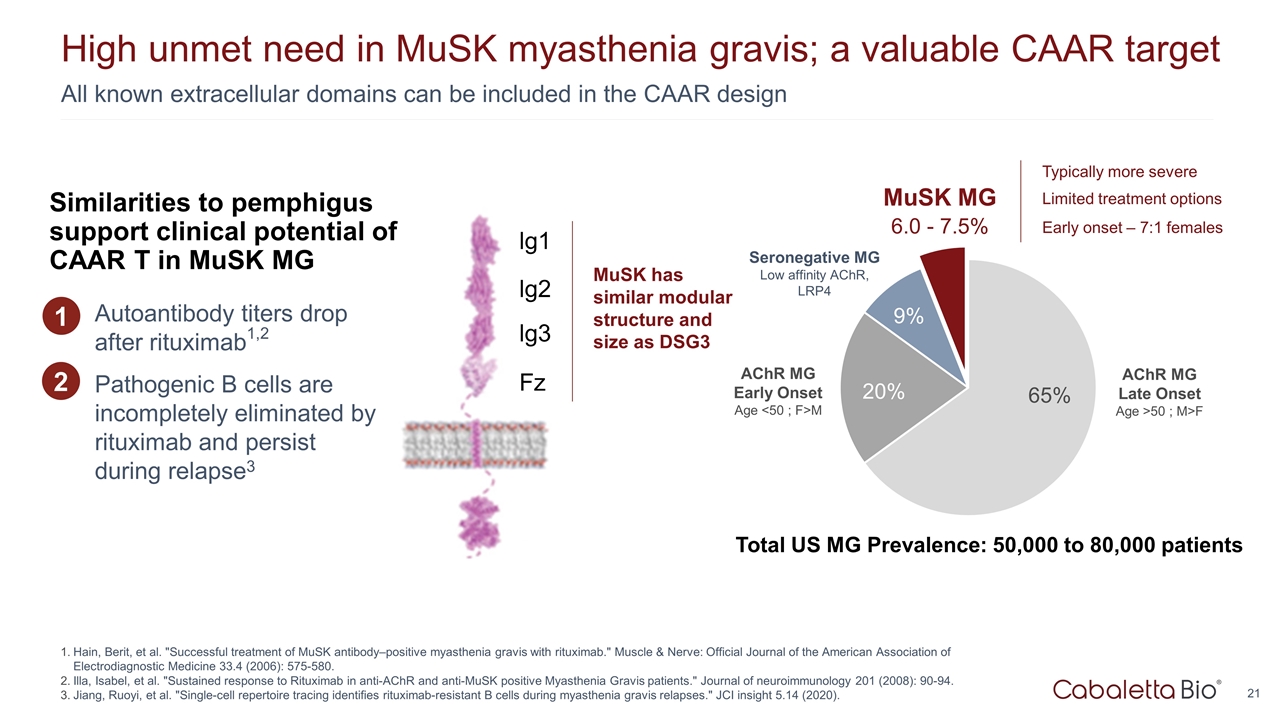
6.0 - 7.5% All known extracellular domains can be included in the CAAR design High unmet need in MuSK myasthenia gravis; a valuable CAAR target Hain, Berit, et al. "Successful treatment of MuSK antibody–positive myasthenia gravis with rituximab." Muscle & Nerve: Official Journal of the American Association of Electrodiagnostic Medicine 33.4 (2006): 575-580. Illa, Isabel, et al. "Sustained response to Rituximab in anti-AChR and anti-MuSK positive Myasthenia Gravis patients." Journal of neuroimmunology 201 (2008): 90-94. Jiang, Ruoyi, et al. "Single-cell repertoire tracing identifies rituximab-resistant B cells during myasthenia gravis relapses." JCI insight 5.14 (2020). AChR MG Early Onset Age <50 ; F>M AChR MG Late Onset Age >50 ; M>F MuSK MG Seronegative MG Low affinity AChR, LRP4 Total US MG Prevalence: 50,000 to 80,000 patients Typically more severe Limited treatment options Early onset – 7:1 females MuSK has similar modular structure and size as DSG3 lg1 lg2 lg3 Fz Autoantibody titers drop after rituximab1,2 Pathogenic B cells are incompletely eliminated by rituximab and persist during relapse3 1 Similarities to pemphigus support clinical potential of CAAR T in MuSK MG 2
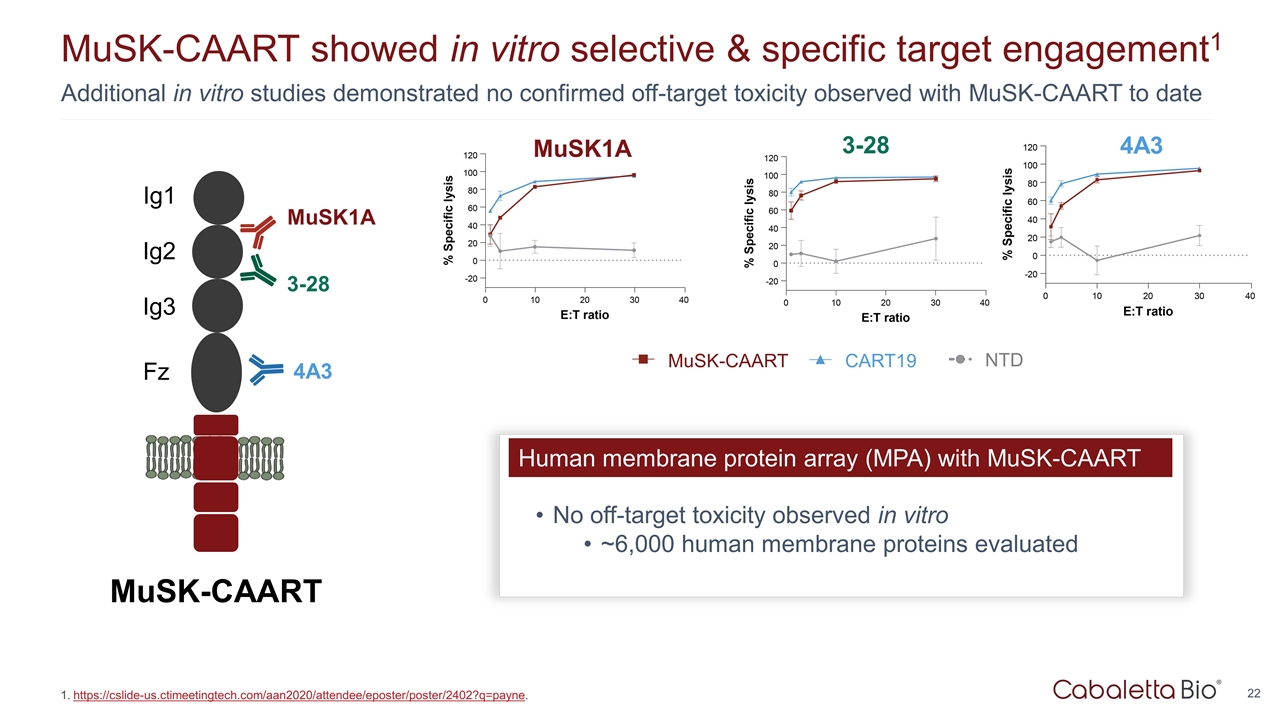
Additional in vitro studies demonstrated no confirmed off-target toxicity observed with MuSK-CAART to date MuSK-CAART showed in vitro selective & specific target engagement1 https://cslide-us.ctimeetingtech.com/aan2020/attendee/eposter/poster/2402?q=payne. MuSK-CAART Ig1 Ig2 Ig3 Fz MuSK1A 3-28 4A3 CART19 MuSK-CAART NTD MuSK1A 3-28 4A3 Human membrane protein array (MPA) with MuSK-CAART No off-target toxicity observed in vitro ~6,000 human membrane proteins evaluated
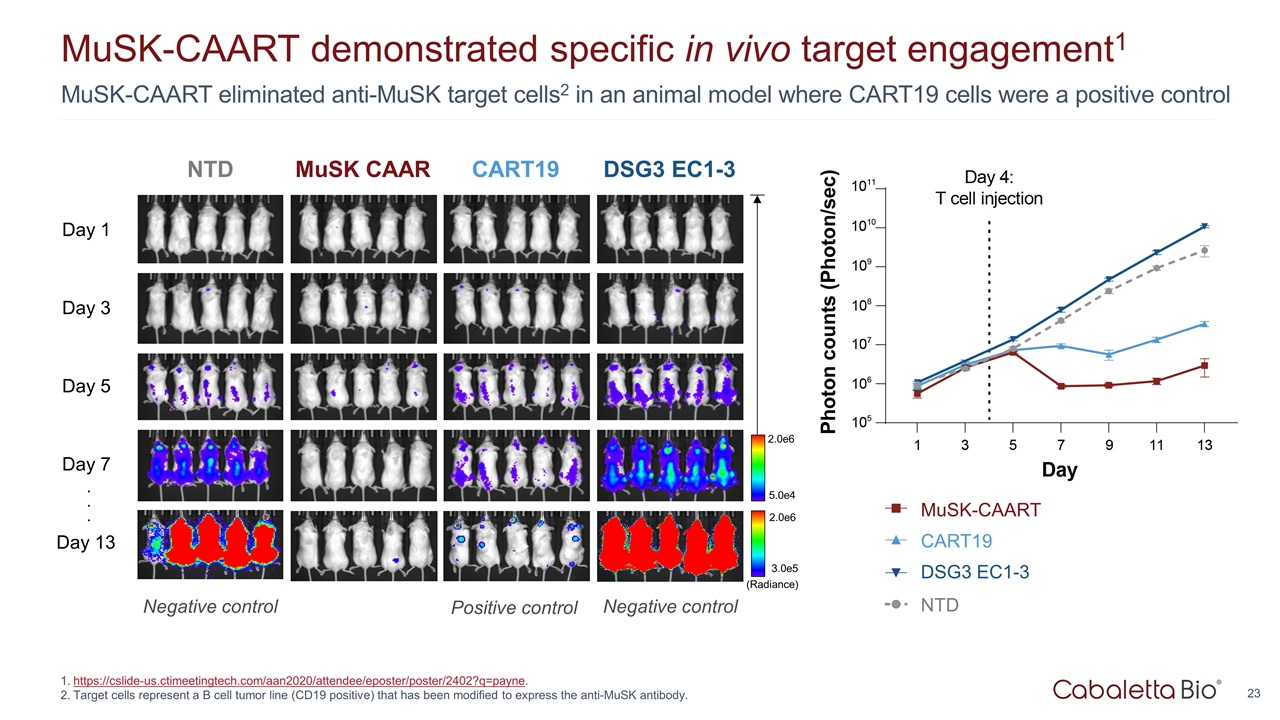
MuSK-CAART eliminated anti-MuSK target cells2 in an animal model where CART19 cells were a positive control MuSK-CAART demonstrated specific in vivo target engagement1 https://cslide-us.ctimeetingtech.com/aan2020/attendee/eposter/poster/2402?q=payne. Target cells represent a B cell tumor line (CD19 positive) that has been modified to express the anti-MuSK antibody. MuSK CAAR CART19 DSG3 EC1-3 Day 1 Day 3 Day 5 Day 7 Day 13 5.0e4 2.0e6 (Radiance) 3.0e5 2.0e6 . . . NTD Positive control Negative control Negative control CART19 MuSK-CAART DSG3 EC1-3 NTD

Manufacturing
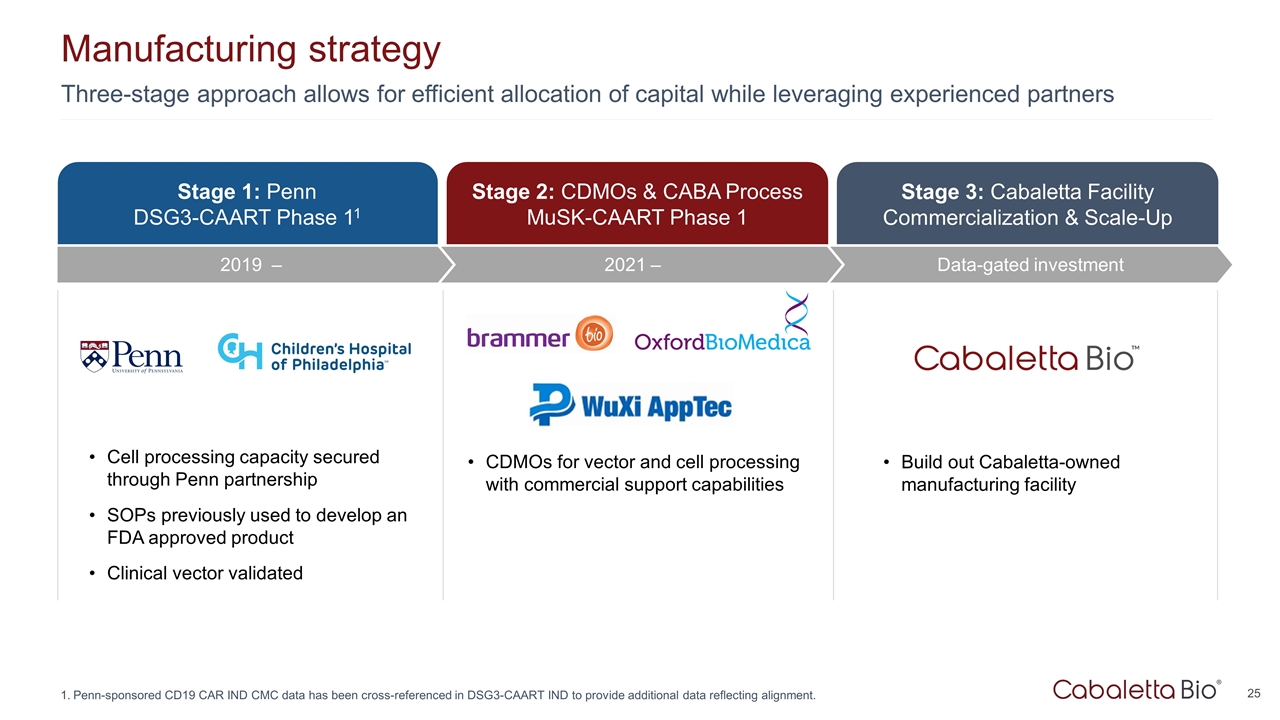
Three-stage approach allows for efficient allocation of capital while leveraging experienced partners Manufacturing strategy Penn-sponsored CD19 CAR IND CMC data has been cross-referenced in DSG3-CAART IND to provide additional data reflecting alignment. Stage 3: Cabaletta Facility Commercialization & Scale-Up Data-gated investment Stage 1: Penn DSG3-CAART Phase 11 Stage 2: CDMOs & CABA Process MuSK-CAART Phase 1 Cell processing capacity secured through Penn partnership SOPs previously used to develop an FDA approved product Clinical vector validated CDMOs for vector and cell processing with commercial support capabilities Build out Cabaletta-owned manufacturing facility 2021 – 2019 –
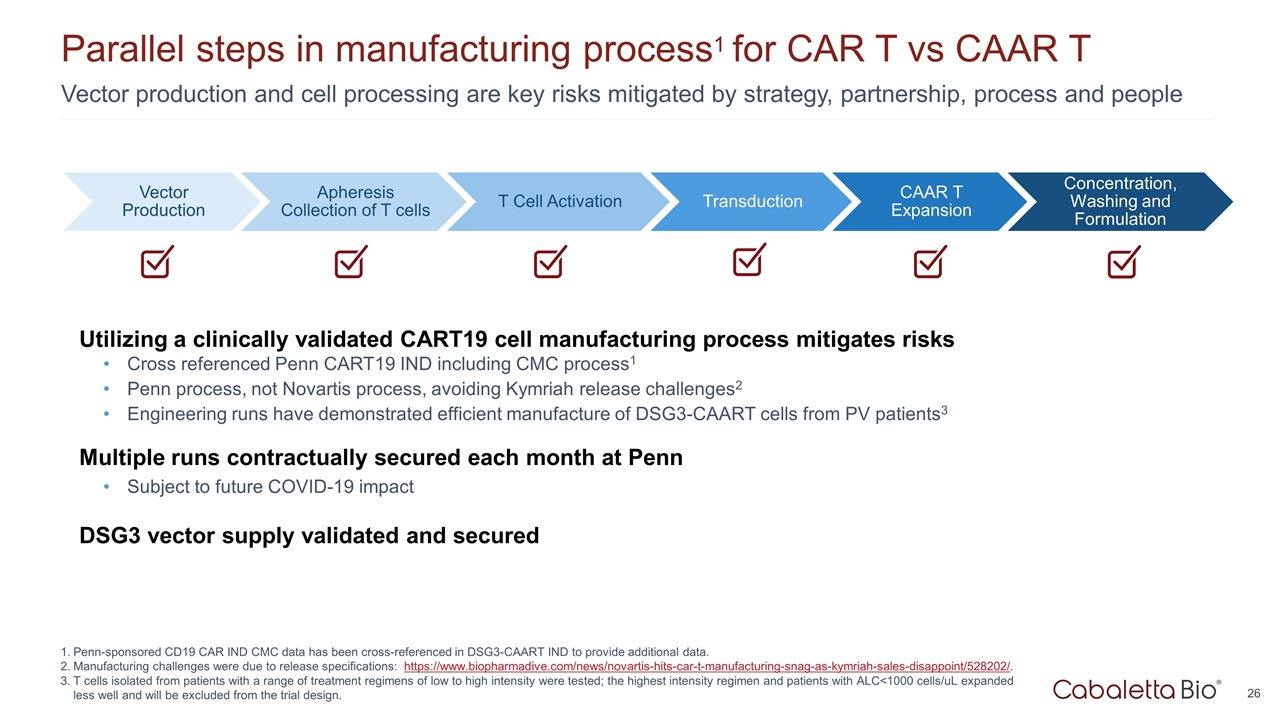
Utilizing a clinically validated CART19 cell manufacturing process mitigates risks Cross referenced Penn CART19 IND including CMC process1 Penn process, not Novartis process, avoiding Kymriah release challenges2 Engineering runs have demonstrated efficient manufacture of DSG3-CAART cells from PV patients3 Multiple runs contractually secured each month at Penn Subject to future COVID-19 impact DSG3 vector supply validated and secured Vector production and cell processing are key risks mitigated by strategy, partnership, process and people Parallel steps in manufacturing process1 for CAR T vs CAAR T Penn-sponsored CD19 CAR IND CMC data has been cross-referenced in DSG3-CAART IND to provide additional data. Manufacturing challenges were due to release specifications: https://www.biopharmadive.com/news/novartis-hits-car-t-manufacturing-snag-as-kymriah-sales-disappoint/528202/. T cells isolated from patients with a range of treatment regimens of low to high intensity were tested; the highest intensity regimen and patients with ALC<1000 cells/uL expanded less well and will be excluded from the trial design. Vector Production T Cell Activation Transduction CAAR T Expansion Concentration, Washing and Formulation Apheresis Collection of T cells

Corporate Summary

SCIENTIFIC ADVISORY BOARD Leadership team Aimee Payne, M.D., Ph.D. Co-Founder and Co-Chair Michael C. Milone, M.D., Ph.D. Co-Founder and Co-Chair Jay Siegel, M.D. LEADERSHIP TEAM Steven Nichtberger, M.D. President, CEO & Chairman Anup Marda Chief Financial Officer Arun Das, M.D. Senior Director BD Gwendolyn Binder, Ph.D. EVP Science & Technology David J. Chang, M.D., M.P.H. Chief Medical Officer J. Brian Stalter, J.D. General Counsel Martha O’Connor Chief HR Officer Iain McInnes, PhD, FRCP, FRSE, FMedSci Carl June, M.D.
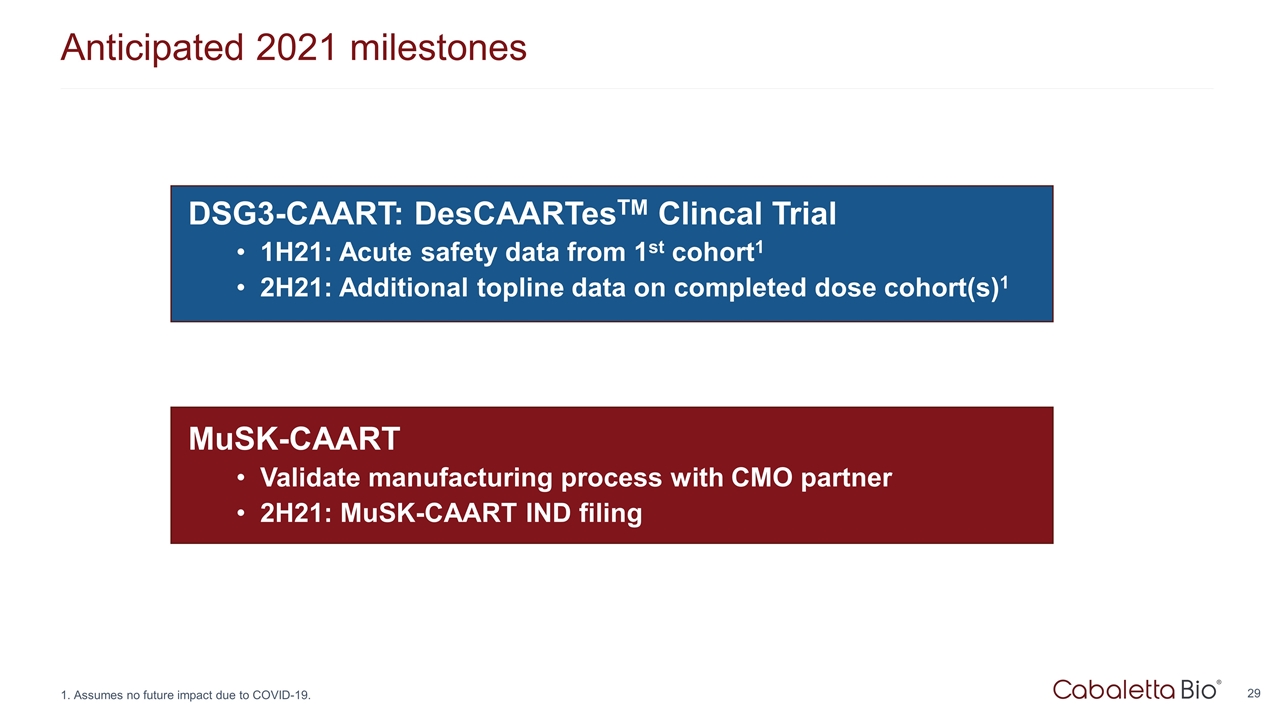
Anticipated 2021 milestones DSG3-CAART: DesCAARTesTM Clincal Trial 1H21: Acute safety data from 1st cohort1 2H21: Additional topline data on completed dose cohort(s)1 MuSK-CAART Validate manufacturing process with CMO partner 2H21: MuSK-CAART IND filing 1. Assumes no future impact due to COVID-19.

Corporate Presentation April 2021